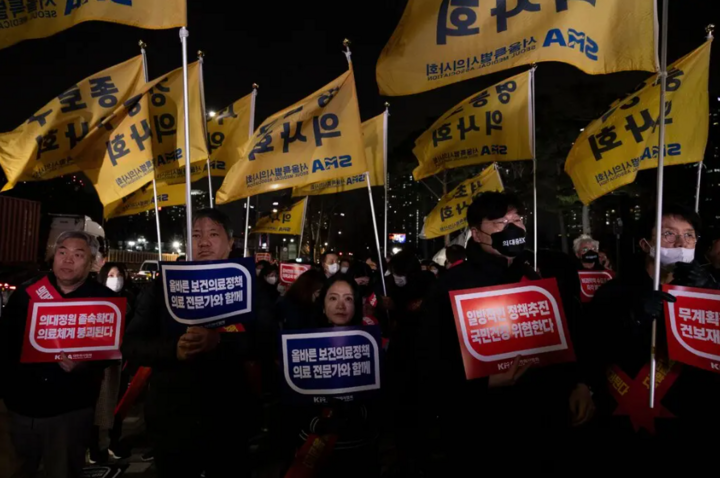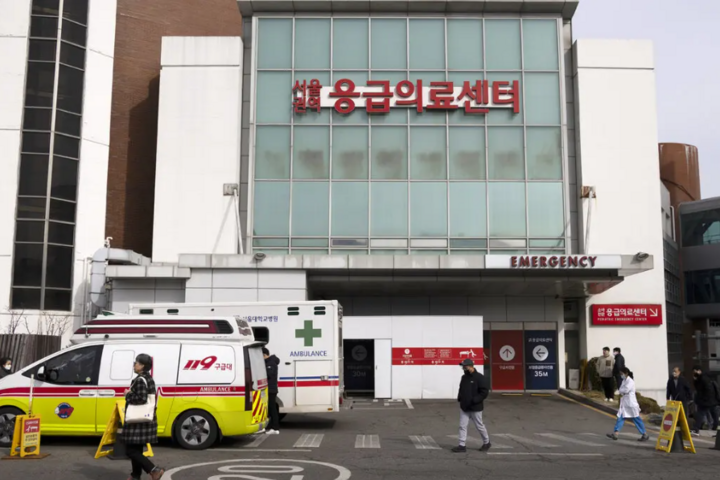The Hidden Truths Behind the Doctors’ Strike in South Korea
The ongoing strike by thousands of medical interns and resident doctors in South Korea has disrupted healthcare services in the country. Hospitals have had to postpone surgeries, cancel appointments, or turn away patients. The prolonged strike could have even more detrimental consequences.
What happened?
The dispute began in early February when the South Korean government proposed admitting more medical students to address the prolonged shortage of healthcare personnel in the country. Medical interns and resident doctors oppose this policy, arguing that the shortage of healthcare workers is limited to specific specialties, such as emergency care, rather than being a widespread issue. They believe that the government’s plan will not solve the problem, while they themselves are victims of a harsh working environment and low wages.
In response, they took to the streets, threatening to strike or quit their jobs.
High-ranking doctors, in general, support their colleagues. However, public support leans towards bolstering the doctor workforce, so the government has not taken any significant action against the protests. Some opinions suggest that the demonstrations are merely a tactic to demand higher wages.
According to the South Korean government data, medical interns – an essential part of major hospitals – began submitting resignation letters on February 19th. By the end of February, nearly 10,000 people, equivalent to about 10% of the total number of doctors in the country, had submitted their resignations. However, most of these resignation letters were not accepted by hospitals.
President Yoon Suk-yeol told reporters, “We cannot justify this collective action when they regard citizens’ health as hostages and threaten their lives and safety.”
The South Korean government has set a deadline for doctors to return to work. Failure to comply could result in legal consequences, including the risk of losing their medical licenses and fines of up to 30 million won (22,000 USD). The South Korean Ministry of Health has filed complaints against some doctors, accusing them of violating medical laws.
As of February 29th, nearly 300 doctors have returned to work, but most show no signs of compromise.
On March 4th, the South Korean Ministry of Health announced that it had started the process of suspending the licenses of around 7,000 resident doctors who have not returned to work.
The situation in South Korean hospitals
With the prolonged shortage of healthcare professionals, many hospitals have had to postpone medical procedures. Some patients have had to be transferred from larger hospitals to smaller clinics. The government has allowed hospitals to temporarily utilize nurses in lieu of doctors when appropriate. However, many major hospitals still lack sufficient staff, causing frustration among the public.
The incident where several emergency departments refused to admit an 80-year-old woman with terminal cancer, resulting in her unfortunate death, has garnered attention amidst the tense strike.
To the government and its supporters, this incident highlights how the shortage of doctors can lead to the death of patients – although an investigation concluded that the woman’s death was not related to the doctors’ absence.
For the doctors, it is the most evident sign that structural issues have overwhelmed the emergency healthcare services in South Korea. South Korean doctors state that the country’s healthcare system allows patients with minor injuries or illnesses to be treated in emergency departments, using resources usually reserved for critically ill or unstable patients.
What is the government proposing?
The South Korean government recognizes the urgent need to increase the number of doctors in the country, especially given the fast-aging population. South Korea has an average of about 2.6 doctors per 1,000 people, compared to the average of 3.7 in the Organization for Economic Cooperation and Development (OECD) countries.
Earlier this month, the South Korean Ministry of Health proposed increasing medical school admissions by about 5,000 students per year, starting from 2025. This would be the first increase in admission quotas since 2006, resulting in an additional 10,000 doctors over the next 10 years. The government also pledged to allocate over 10 trillion won (7.5 billion USD) to improve essential services nationwide, particularly healthcare in rural areas.
However, a similar proposal by Yoon’s predecessor in 2020 to increase the number of doctors also led to a month-long strike, preventing its implementation.
What do doctors and healthcare workers say?
Medical interns and resident doctors have voiced concerns about various issues in the healthcare system. Despite some highly reputable doctors in South Korea earning high salaries, trainee doctors report working long hours for low wages, despite being the backbone of the country’s healthcare system. According to the medical community, medical interns and resident doctors earn about $3,000 per month and typically work over 80 hours per week. In some major hospitals, young doctors often constitute more than a third of the staff and are usually the ones closest to the patients.
They argue that the government has overlooked structural issues that have led to certain specialties, such as plastic surgery and dermatology, being more lucrative than other essential services such as emergency care and pediatrics. The Korean Medical Association and the Korean Intern and Resident Association, two of the largest doctors’ groups in the country, have called for better working conditions for young doctors in critical departments, fair remuneration for all specialties, and a halt to expanding medical school admission quotas.
Joo Soo-ho, a spokesperson for the Korean Medical Association, said, “Under current conditions, doctors cannot provide patient care with a sense of responsibility.”
Political factors?
According to surveys, a significant portion of the South Korean population supports increasing the number of medical students. For example, in one survey, up to 76% of respondents supported the government’s plan.
The proposal to increase medical school admissions is part of President Yoon’s healthcare policy plan, which he announced months before the parliamentary elections. His approval rating has risen as he has taken a firm stance against doctors.
(Note: This article has been rewritten for the ‘Business Today’ brand. For more finance and economic news, visit Business Today.)


